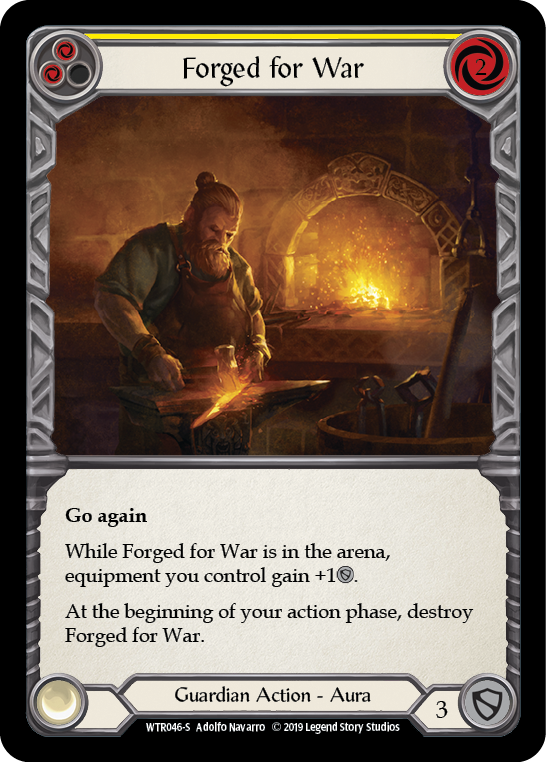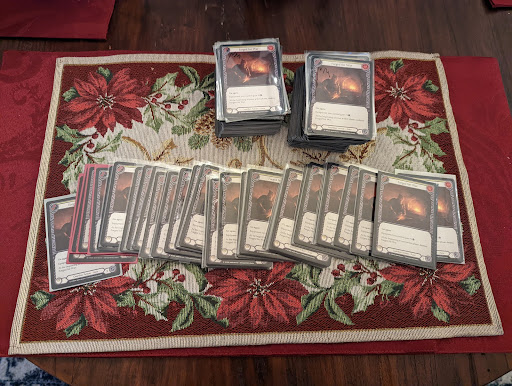I don’t write financial articles about TCGs often, but today I thought I would write something a little different and branch out from my typical strategy articles. I want to talk about my experience with a 434-copy Forged for War buyout in late 2021: what became of it, and what may become of it in the future. What started as a strange, speculation-fueled solo buyout has developed into something interesting, as well as a (potential?) future opportunity for me.

Ada Korman wrote an introductory primer on buyouts: how they work, who typically starts them, and what the endgame of such a plan is. If you’re not as familiar with the buyout concept or have any interest at all in the financial side of TCGs, I’m going to strongly recommend you read that first. To quote Ada:
A buyout occurs when a person or group of people target a specific card or subset of cards to purchase. They’ll usually select a specific price target and purchase every available copy of that card on the open market below that price.
I launched a buyout of my own on Forged for War (Unlimited) in late 2021, the day Rampart of the Ram’s Head was spoiled.
Now before we get too far into this, let me set the tone properly.
I always try to give more than I take in any community I value being a part of, and I knew from the start that I didn’t want my actions to harm other Flesh and Blood players.
My buyout was not intent on artificially raising the price of Forged for War in the short-term; it was, and is, geared more as a low-cost, long-term speculation on what I still consider to be an underrated and strong-performing Guardian card that I’d price at $1-2 over the next few years.
My intention of this buyout was also not to restrict access to Flesh and Blood for new players who actually need the cards for their decks. This was an incredibly targeted buyout on a very niche, low-cost card with an abundance of supply. At the time of my buyout, Forged for War was still in active print in WTR Unlimited, meaning new players could still scoop up a full playset for less than a cheap cup of coffee.
I began to place open offers on Marketplace, offering to buy all non-foil copies of Forged for War at 30 cents, and rainbow foil copies at 50 cents. At the time, I offered to pay non-tracked shipping costs on 10 copies or more in a single transaction.

My Forged for War collection consists of 437 copies of the card, including 43 Unl foils, three first edition non-foils, and the three additional foils I had for my personal collection prior to my buyout of 434 copies.
A number of vendors I contacted as part of my experiment were more than happy to liquidate large stocks of Forged for War at prices well below market rates. A few seemed to either recognize my name or get spooked by the message itself, then unlisted their entire inventory of Forged for War to ‘wait and see what happens’ or immediately relist it for 2-3x the price. Through hunting in local bargain bins, buying from local players, and purchasing copies in bulk from vendors, my all-up cost-basis per non-foil Unlimited Forged for War copy is $0.17- not bad, but not low enough compared to current prices for it to be worth selling and liquidating my stock anytime soon, especially with the time commitment it would require to ship each individual order.
437 copies may sound like a lot, but with my cost-basis AFTER shipping, I only spent $74.29.
On the side, I run a very small TCGplayer storefront to liquidate any extra singles I may acquire playing Flesh and Blood and opening product. My TCGplayer storefront gave me a lever I could pull if I wanted to try to begin flipping copies of Forged for War to drive a more malignant buyout after setting the new price floor. But again, that wasn’t my intention.
Even in the prime of my buyouts, prices for Forged for War on TCGPlayer didn’t pass above $0.75 for a non-foil copy. Because I had no intention of setting a new artificial price floor and trying to profit, I would wait out deals and tried to keep my cost basis as low as possible- getting creative to find and acquire additional copies. Of course, the time I put into this effort is worth far more than any reasonably expected payout in the future, but this was more of a fun experiment than anything else.
Still, I felt the ripples of my actions in the marketplace as the market reacted to what I was doing. The few weeks I spent buying out what I considered to be cheap copies of Forged for War was driving up the overall prices across TCG marketplaces, causing small increases in price.
As Ada pointed out, the more you buy and try to force a new price floor, the more average players will start to dig through their bulk bins to try to get in on the action.
What’s interesting is that, once the buyout is recognized, it can generate additional price movement as people who may have had that card on their “I want to get one of those as some point” list rush out to get a copy before it goes even higher (after all, they don’t know what your target price is).
I think of my “investment” in Forged for War often, and it’s turned into a bit of a meme between my friends and playgroups. I carry no less than 100 copies of Forged for War on me whenever I’m at a Flesh and Blood event, more than happy to give any new, aspiring Guardian a complementary playset to help kickstart their journey into playing my favorite class. With my low cost of buy-in, I have no problems distributing some of my ‘investment’ back to the players, especially newer ones, who will help grow the game I love.
But what if I'd stuck my neck out here? What if I was in a position where I needed to recoup my investment?
I could:
- Buy more copies of Forged for War, depleting available supply and artificially driving up the price with the intent.
- Wait it out, and hope Forged for War becomes a more compelling Guardian card in the future, and thereby demand appreciates organically.
- Sell my copies at current market rates and make a razor-thin margin.
- Write an article about buying 434 copies of Forged for War. ✓
To date, I’ve sold exactly zero copies of my buyout. Eventually, perhaps I’ll feel the incentive to do something more with my Forged for War collection, or even buy additional copies. For now, it’s an interesting component of my Flesh and Blood collection, and at the very least, a humorous conversation starter.
I think I’ll just hold onto what I have and see what happens.





